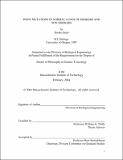| dc.contributor.advisor | William G. Thilly. | en_US |
| dc.contributor.author | Sudo, Hiroko, 1977- | en_US |
| dc.contributor.other | Massachusetts Institute of Technology. Biological Engineering Division. | en_US |
| dc.date.accessioned | 2007-02-22T15:55:19Z | |
| dc.date.available | 2007-02-22T15:55:19Z | |
| dc.date.copyright | 2004 | en_US |
| dc.date.issued | 2004 | en_US |
| dc.identifier.uri | http://hdl.handle.net/1721.1/36321 | |
| dc.description | Thesis (Ph. D. in Genetic Toxicology)--Massachusetts Institute of Technology, Biological Engineering Division, 2004. | en_US |
| dc.description | This electronic version was submitted by the student author. The certified thesis is available in the Institute Archives and Special Collections. | en_US |
| dc.description | Includes bibliographical references (p. 139-161). | en_US |
| dc.description.abstract | It is a widely-held hypothesis that environmental mutagens play an essential role in human somatic and germinal cell mutagenesis. In particular, the finding of small amounts of chemical mutagens in cigarette smoke has led to the general hypothesis that mutagens in cigarette smoke induce oncomutations and thus account for the carcinogenic effect of cigarette smoking in human lungs. However, this hypothesis has not been tested by an assay of nuclear point mutations in lungs of smokers and nonsmokers. Mismatch amplification mutation assay (MAMA), an effective form of allele-specific PCR, was applied for detection of point mutations in TP53 bp742, bp746 and bp747, K-ras bp35 and HPRT bp508 from a total of 291 tracheal-bronchial epithelial sectors from six smokers and nine non-smokers, yielding 949 individual mutational assays. The conditions of MAMA for each target point mutations were optimized such that the sensitivity of each was equal to or below 10⁻⁵. Lung epithelial sectors of 2.3x10⁶ cells in average contained 0-200 mutant cells in general, equivalent to mutant fractions (MFs) of 0-10⁻⁴ with an exception of rare sectors with MF larger than 4x 10⁻⁴ (4.6%). Noticeably, the distributions of the MFs among sectors did not vary appreciably with the donor's smoking status. The mean MFs per lung were very similar between smokers and non-smokers for all five target mutations assayed (p >> 0.05). The mean MFs were slightly higher in females than males (p = 0.015). The mean MFs increased with age of the subjects although the correlation did not reach statistical significance due to large variances within the same age group. The distributions of MF among sectors of smokers and non-smokers did not differ significantly by Kolmogorov-Smirnov test | en_US |
| dc.description.abstract | (cont.) for all target mutations but HPRT. By using hypothetical turnover unit sizes and Poisson distribution, the turnover unit size of human tracheal bronchial epithelium was estimated as 64 cells (p = 0.05). These observations do not support the widely-held hypothesis that cigarette smoking causes lung cancer through its induction of point mutations in nuclear genes. The current findings demonstrate the necessity of investigation on alternative mechanisms for tobacco smoke in lung carcinogenesis. | en_US |
| dc.description.statementofresponsibility | by Hiroko Sudo. | en_US |
| dc.format.extent | 194 p. | en_US |
| dc.language.iso | eng | en_US |
| dc.publisher | Massachusetts Institute of Technology | en_US |
| dc.rights | MIT theses are protected by copyright. They may be viewed, downloaded, or printed from this source but further reproduction or distribution in any format is prohibited without written permission. | en_US |
| dc.rights.uri | http://dspace.mit.edu/handle/1721.1/7582 | |
| dc.subject | Biological Engineering Division. | en_US |
| dc.title | Point mutations in normal lungs of smokers and non-smokers | en_US |
| dc.type | Thesis | en_US |
| dc.description.degree | Ph.D.in Genetic Toxicology | en_US |
| dc.contributor.department | Massachusetts Institute of Technology. Department of Biological Engineering | |
| dc.identifier.oclc | 55590318 | en_US |
